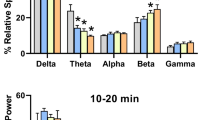Abstract.
Rationale: γ-Aminobutyric acid (GABA) is the main inhibitory transmitter of the brain. The involvement of GABAA and GABAB receptors in sleep-waking processes is well established. Objectives: This research studied the influence of GABAC receptors. Methods: The rats were randomly infused in the fourth ventricle with vehicle and 25, 50, and 100 µg (1,2,5,6,-tetrahydropyridine)-methylphosphinic acid (TPMPA), a specific antagonist of GABAC receptors. Results: Principally at 50 µg, the molecule induced an increase of waking from 44.7% to 61.7% (P<0.003), which was the consequence of enhancement of both active and quiet wakefulness. Total slow wave sleep was decreased, particularly the slow-wave stage from 39% to 27.7% (P<0.02). Paradoxical sleep was also decreased from 14.5% to 9.1% (P<0.01). Conclusions: GABAC receptors are also involved in sleep-waking regulation. Since the sensitivity of GABAC receptors to GABA is much higher than that of GABAA and GABAB receptors, GABAC receptor modulators could be potential medications acting at low doses with fewer side effects.
Similar content being viewed by others
Author information
Authors and Affiliations
Additional information
Electronic Publication
Rights and permissions
About this article
Cite this article
Arnaud, C., Gauthier, P. & Gottesmann, C. Study of a GABAc receptor antagonist on sleep-waking behavior in rats. Psychopharmacology 154, 415–419 (2001). https://doi.org/10.1007/s002130000653
Received:
Accepted:
Issue Date:
DOI: https://doi.org/10.1007/s002130000653




